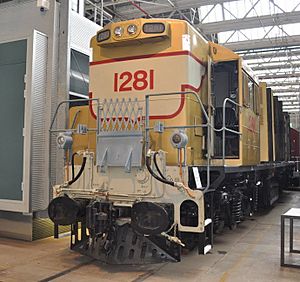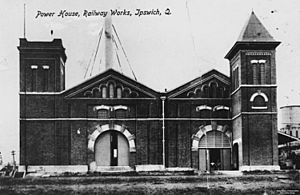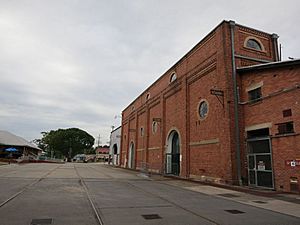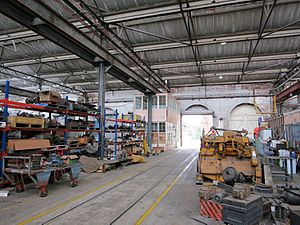North Ipswich Railway Workshops facts for kids
Quick facts for kids North Ipswich Railway Workshops |
|
|---|---|
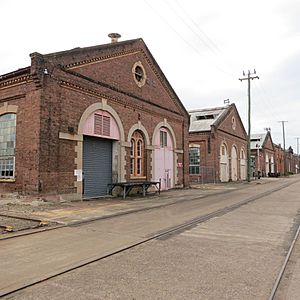
North Ipswich Railway Workshops, 2016
|
|
| Location | North Street, North Ipswich, Queensland, Australia |
| Design period | 1840s - 1860s (mid-19th century) |
| Built | 1878 - 1980s |
| Official name: North Ipswich Railway Workshops Complex | |
| Type | state heritage (built) |
| Designated | 21 April 1997 |
| Reference no. | 601526 |
| Significant period | 1878- 1980s (fabric) 1864-1995 (historical operation of workshops at site) |
| Significant components | furnace, forge/blacksmithy, garden - bed/s, office/administration building, office/s, toilet block/earth closet/water closet, workshop, crane / gantry, tramway, turntable, tank stand, maintenance facility, railway siding, tower, trees/plantings, tower - water, engine/generator shed/room / power supply, traverser, warehouse, railway, pump house, boiler room/boiler house, machinery/plant/equipment - engineering and construction, machinery/plant/equipment - utilities - gas/electricity supply, mill - timber / sawmill, store/s / storeroom / storehouse |
| Lua error in Module:Location_map at line 420: attempt to index field 'wikibase' (a nil value). | |
The North Ipswich Railway Workshops are a historic site in North Ipswich, Queensland, Australia. These workshops were once a very important place where trains were built and repaired. They operated from 1878 until the 1980s. Today, part of the site is known as the Workshops Rail Museum, where you can learn all about Queensland's railway history. This special place was added to the Queensland Heritage Register on 21 April 1997 because of its importance.
Contents
The Start of Queensland's Railways
Queensland's first railway line began in Ipswich, not the capital city of Brisbane. This was unusual! The idea was to connect Ipswich with the rich farming areas of the Darling Downs. Boats already carried goods between Brisbane and Ipswich on the Brisbane River.
Work on the railway started in 1864. The first part of the line opened in 1865. It slowly grew to reach the Darling Downs and beyond. The line connecting Ipswich to Brisbane was finished in 1875. The first workshops were also built in Ipswich, on the southern side of the current site.
Early workshop buildings included two "erecting shops" that came from England. They were made with cast iron frames and corrugated zinc walls. These original buildings are no longer standing.
Building Trains and More
At first, the North Ipswich Railway Workshops only assembled and maintained trains. This was because the first locomotives in Queensland came from Britain. In 1865, the workshops built their first piece of rolling stock: an engine truck. They built ten wagons in 1866.
The workshops quickly improved. In 1877, they built their first locomotive, an A10 class train. It was mostly made from spare parts. Over the years, the workshops built 218 steam locomotives. The last one was a DD17 class in 1952.
The railway line from Ipswich station passed through the workshops site. It then continued west towards the Darling Downs. This section of track within the workshops is still there today.
Growing and Modernising
As the workshops got busier, they needed more space. More land was bought north of the original site. In the 1880s, several large buildings were completed. These included shops for carriages, wagons, painting, and fitting. This set up the basic layout for the future workshops.
However, financial problems and severe floods in 1893 slowed down construction. Work continued, but the buildings were not big enough. After two accidents in the late 1890s, an investigation suggested the workshops should be "enlarged, extended and equipped with most modern tools."
William Nisbet was hired to manage this expansion. He had a big vision for the future. He planned for larger buildings that could hold huge overhead cranes. He also wanted a more efficient way to move work through the shops.
A major change was using electricity. A power house (R.10) became a key new building. A special machine called a traverser was installed. This machine moved equipment between the different workshop sheds.
Other big buildings constructed in the 1900s included the huge Boiler Shop (R.14) and the Carriage and Wagon Shop (R.12). A new Smithy (R.7) and Foundry (R.8) were also built. These new buildings were much larger than the older ones.
After this big building program, some smaller timber buildings were added. These included the Time-keepers Office (R.17) at the front gates and offices for drafting and administration (R.24). A dining room (R.16) was also set up for employees. The workshops also expanded their sawmill to make more of their own timber.
Wartime Efforts
During World War I, about 300 of the 1,600 employees worked on making war supplies. They mainly produced shell casings using steel from BHP.
The workshops also helped with a famous event. In 1919, the Vickers Vimy aircraft of Ross and Keith Smith broke down near Charleville. This happened after they completed the first flight from England to Australia by an Australian crew. The North Ipswich Railway Workshops repaired the engine! They forged new parts and fixed the damaged engine casing. They even made a new propeller from Queensland maple.
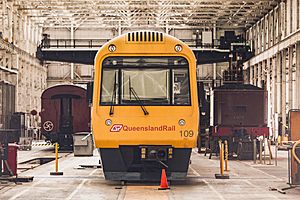
When World War II started in 1939, the workshops again helped with wartime production. In 1942, they produced a 30-ton casting, the largest ever made there.
In 1941, the Australian Government set up a munitions factory in Rocklea. The government needed special tools for mass-production. So, they worked with the Queensland Government to build a new Tool and Gauge Shop (R.19 & R.20) at North Ipswich. This was chosen to help Queensland develop more industries after the war.
From Workshops to Museum
After World War II, Queensland faced challenges with old trains and not enough new production. It was decided that new workshops should be built. The Redbank Railway Workshops opened in 1958. This new site became the main place for diesel locomotives.
In 1995, all remaining work from North Ipswich was moved to Redbank. The closure of the North Ipswich workshops led to their exciting redevelopment. They were turned into the Workshops Rail Museum, which is part of the Queensland Museum. The museum opened in August 2002.
What Makes Them Special?
The North Ipswich Railway Workshops are a large site with many buildings and railway tracks. These were built from 1878 onwards.
Many buildings here are very well designed. The brick buildings from the late 1800s and early 1900s are strong and detailed. They have interesting brickwork patterns and large arched doorways. These buildings, like the Power House and Boiler Shop, show a strong and impressive style.
The Traverser (R30) is a key part of the workshops. It's a large moving platform that helped shift trains between different repair sheds. It shows how railway workshops were planned in the late 1800s.
The Power House (R10) is a great example of early 20th-century engineering. It supplied electricity to the entire workshops complex from 1901-02. This was 16 years before Ipswich even had electricity! It still has old machinery like overhead cranes and a steam-powered pump.
The Tool and Gauge Shop (R18, R19 & R20) is also very important. It was built during World War II to make special tools for munitions (war supplies). It was one of only two such places in Australia at the time.
The workshops also have a tall water tower (R28). It's a landmark on the site and shows how even useful structures can be designed beautifully.
These workshops were a huge employer in Ipswich. They employed over 1,500 people at a time, and sometimes more than 3,000 after World War II. This meant the workshops had a big impact on thousands of families in the city. The people of Ipswich were very proud of what the workshops achieved.
The workshops also created a strong community among its workers. They had their own clubs and even created gardens around their workplaces. This shows how much pride they took in their jobs.


